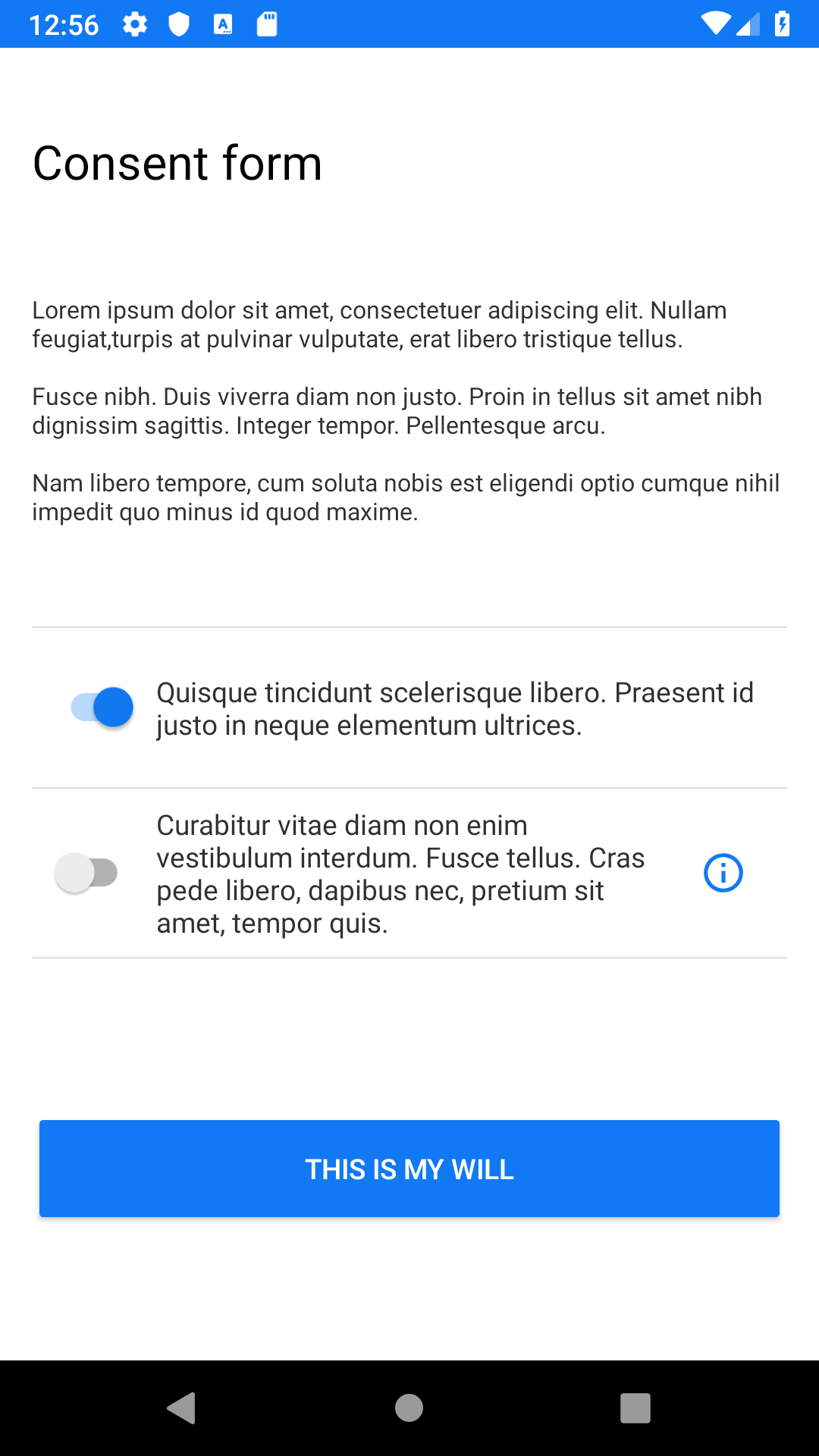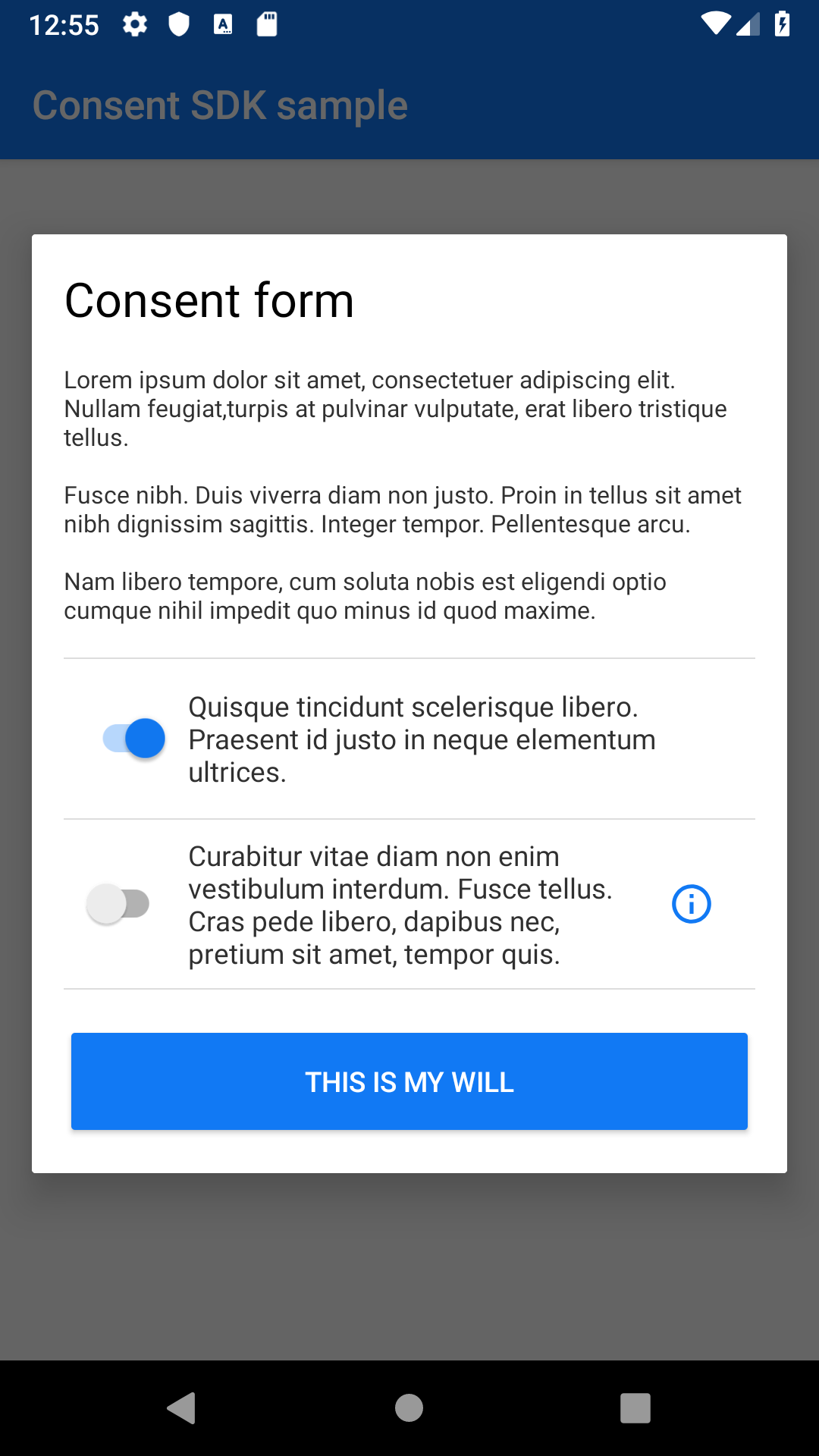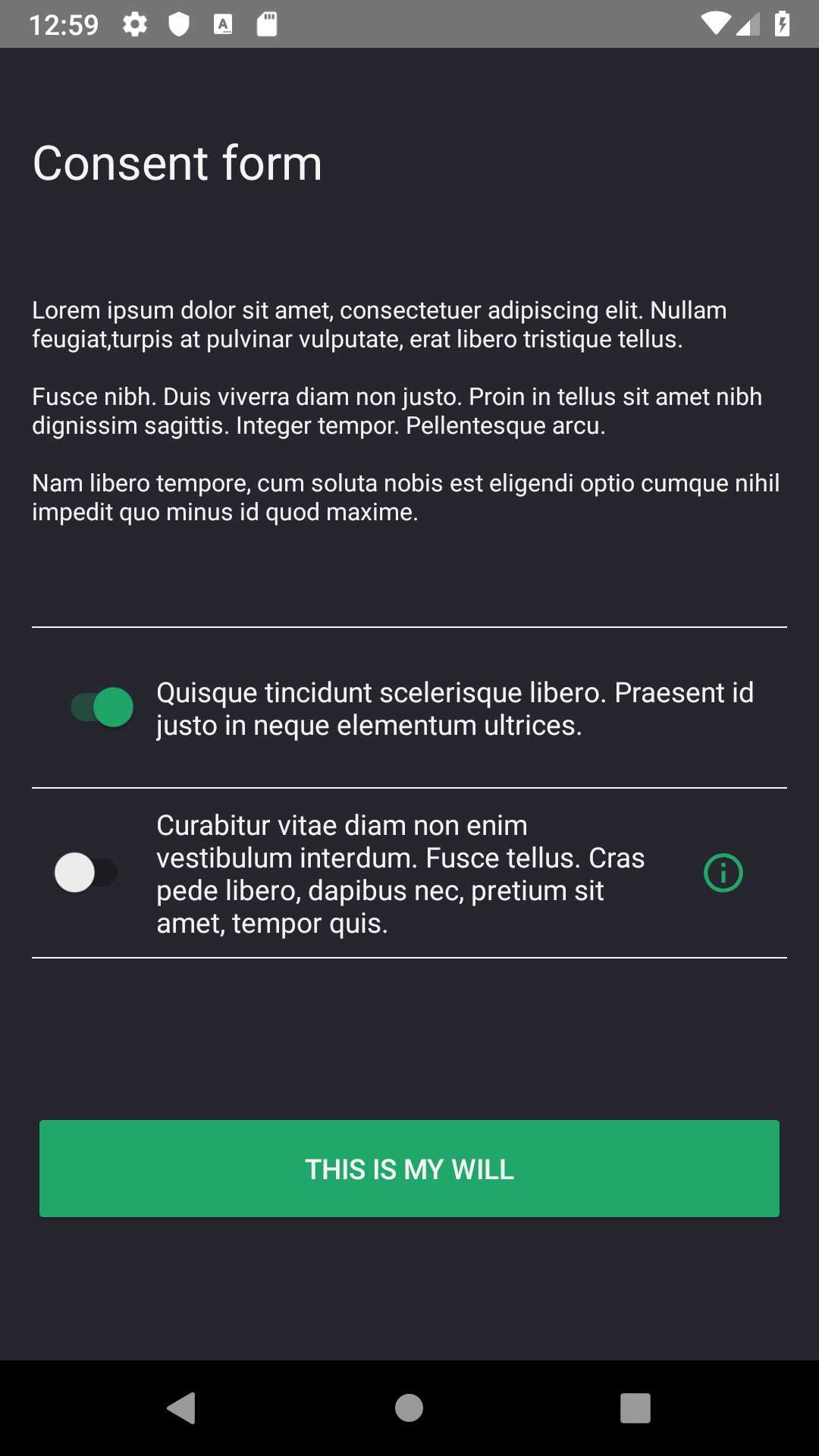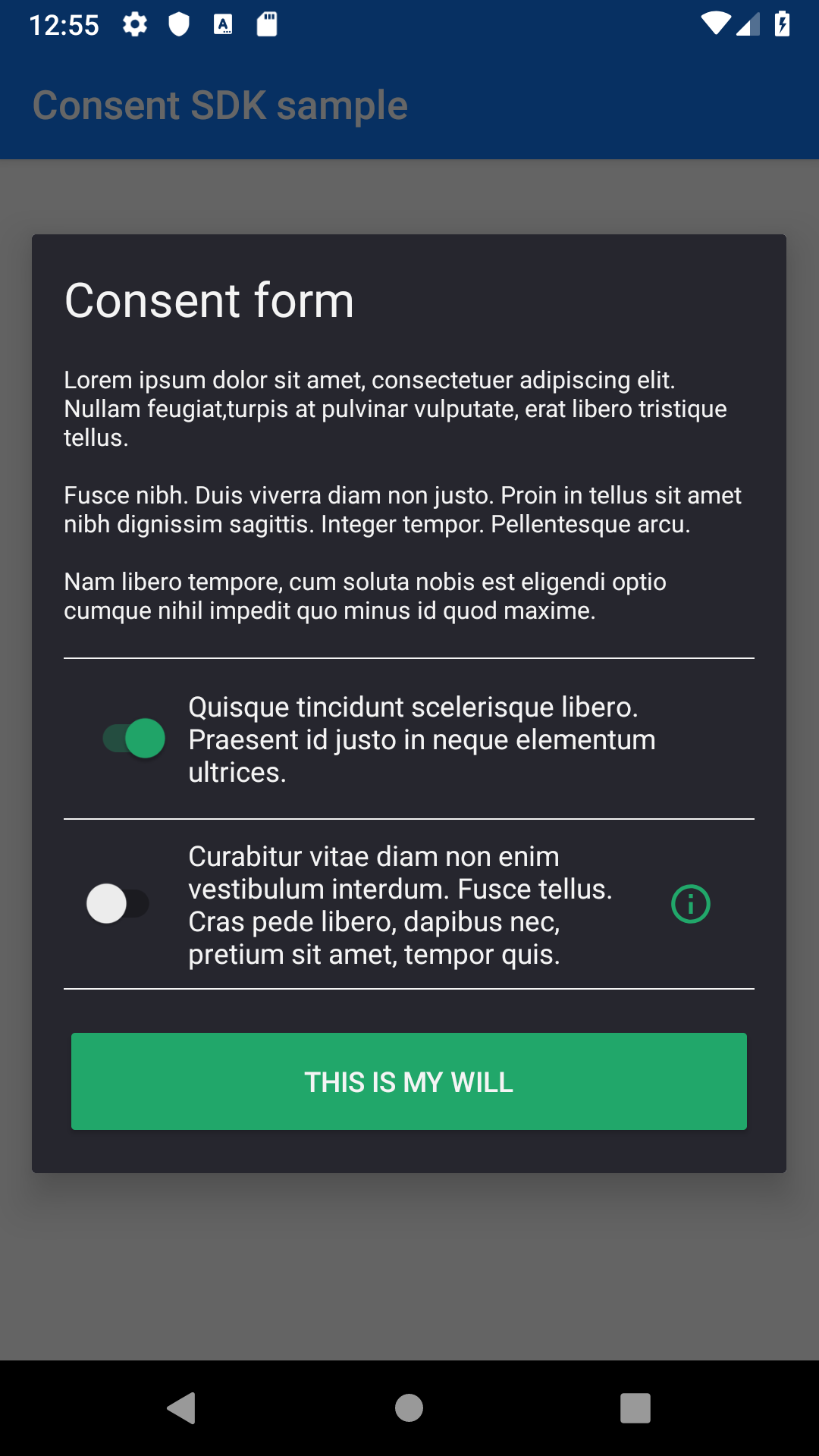smartlook / Android Consent Sdk
Programming Languages
Projects that are alternatives of or similar to Android Consent Sdk
Consent SDK for Android
Obtaining explicit user consent regarding the gathering analytics data in an app, or with processing user’s personal data is an important part of establishing user trust and seamless user experience.
Although implementing some form to obtain user consents and store them for further reference seems pretty straightforward, digging into it reveals (as usual with “simple tasks”) many programming and design details that must be implemented, which are not the core functionality of your app.
Consent SDK main functionality
- Provides configurable consent form that can be displayed as:
- Dialog
- FragmentDialog(persists orientation changes)
- Activity
- Fragment
- Stores consent results and provides access methods.
Installation
Add the following dependency in your app's build.gradle:
implementation 'com.smartlook:consent:1.0'
And add the following in your project's build.gradle:
allprojects {
repositories {
maven {
url "https://sdk.smartlook.com/android/release"
}
}
}
How to use
Firstly you need to instantiate ConsentSDK with applicationContext.
val consentSDK = ConsentSDK(applicationContext)
This object is going to be used for all interactions with ConsentSDK.
Consent form data
Before you can display consent form you need to prepare consent form data.
companion object {
const val CONSENT_1_KEY = "consent_1_key"
const val CONSENT_2_KEY = "consent_2_key"
}
...
val consentFormItems = arrayOf(
ConsentFormItem(
consentKey = CONSENT_1_KEY,
required = true,
description = getString(R.string.consent_1_description),
link = null
),
ConsentFormItem(
consentKey = CONSENT_2_KEY,
required = false,
description = getString(R.string.consent_2_description),
link = getString(R.string.consent_2_link)
)
)
val consentFormData = ConsentFormData(
titleText = getString(R.string.consent_form_title),
descriptionText = getString(R.string.consent_form_description),
confirmButtonText = getString(R.string.consent_form_confirm_button_text),
consentFormItems = consentFormItems)
Array consentFormItems represents consents we want the user to grant us. Every item needs to have:
- unique
consentKeythat represents it and can be used to obtain grant result for this consent. -
requiredflag. If this flag is set totrueuser cannot successfully finish the consent form without granting this consent. -
descriptionTextinforming the user about the consent. -
link(optional) that lets the user open a web page (URL) with more info.
Object consentFormData provides all needed data for displaying consent form.
Showing consent form on Dialog
A most simple and straight-forward way of displaying consent form is on Dialog. It has one drawback, this way we cannot properly persist user data on orientation change. Use this if you have locked screen orientation.
consentSDK.showConsentFormDialog(consentFormData, object : ConsentResultsListener {
override fun onConsentResults(consentResults: HashMap<String, Boolean>) {
// consent form result here
}
})
Showing consent form on DialogFragment
By using DialogFragment SDK can properly handle orientation changes.
consentSDK.showConsentFormDialogFragment(<activity>/<fragment>, consentFormData)
The first parameter of showConsentFormDialogFragment accepts Activity or Fragment reference so you can call it from both.
Your calling Activity or Fragment must implement ConsentResultsListener.
class SampleActivity : AppCompatActivity(), ConsentResultsListener {
...
override fun onConsentResults(consentResults: HashMap<String, Boolean>) {
// consent form result here
}
}
Starting consent form Activity
class SampleActivity : AppCompatActivity() {
companion object {
const val CONSENT_REQUEST_CODE = 10001
}
...
consentSDK.startConsentFormActivity(this, consentFormData, CONSENT_REQUEST_CODE)
...
override fun onActivityResult(requestCode: Int, resultCode: Int, data: Intent?) {
if (requestCode == CONSENT_REQUEST_CODE) {
if (resultCode == Activity.RESULT_OK) {
val consentResults = consentSDK.parseOutConsentResults(data)
} else {
// user didnt confirm the form (back press)
}
}
}
}
Consent form Activity is started "for a result" so to get a result you need to implement onActivityResult method in your Activity.
Creating conset form Fragment
Method createConsentFormFragment lets you create Fragment with consent form. Example usage might look something like this:
const val TAG = "unique_fragment_tag"
...
with(supportFragmentManager) {
beginTransaction()
.replace(R.id.fragment_placeholder, consentSDK.createConsentFormFragment(consentFormData), TAG)
.commit()
executePendingTransactions()
}
ConsentResultsListener can be registered like this:
val consentFormFragment = supportFragmentManager.findFragmentByTag(TAG) as ConsentFormFragment
consentFormFragment.registerConsentResultsListener(object : ConsentResultsListener {
override fun onConsentResults(consentResults: HashMap<String, Boolean>) {
// Consent form result here
}
})
Consent results
When user sucessfully finishes consent form you gonna get consentResult. It is a HashMap<String,Boolean> in which:
-
key==consentKey -
valuerepresentsconsentResult:-
trueconsent was granted. -
falseconsent was rejected.
-
Are consent results stored?
SDK method areConsentResultsStored() can be used to determine if the user has already successfully filled consent form and results were stored.
Obtaining consent
If you want to obtain a grant result for given conset (identified by unique consentKey) you can do it like this:
val consentResult = consentSDK.loadConsetResult(consentKey)
If consentResult is:
-
trueconsent was granted. -
falseconsent was rejected. -
nullnot defined.
Styling
You can define custom style for the consent form. All configurable attributes are listed in the table below.
| Attribute | Description |
|---|---|
| colorAccent | Confirm button, link icons and Switches color. |
| cf_textColor | Description text and form item texts color. |
| cf_titleTextColor | Title text color. |
| cf_confirmButtonTextColor | Confirm button text color. |
| cf_backgroundColor | Form background color. |
| cf_dividerColor | Form item list divider color. |
Dialog/FragmentDialog
In styles.xml define custom Dialog style:
<style name="DialogStyle" parent="Base.Theme.AppCompat.Light.Dialog">
<item name="colorAccent">#35E6A5</item>
<item name="cf_textColor">#F4F4F4</item>
<item name="cf_titleTextColor">#F4F4F4</item>
<item name="cf_confirmButtonTextColor">#F4F4F4</item>
<item name="cf_backgroundColor">#26262E</item>
<item name="cf_dividerColor">#F4F4F4</item>
</style>
Then add the style reference to showConsentFormDialog/showConsentFormDialogFragment method like this:
// Dialog
consentSDK.showConsentFormDialog(this, consentFormData, R.style.DialogStyle, listener)
// DialogFragment
consentSDK.showConsentFormDialogFragment(this, consentFormData, R.style.DialogStyle)
Activity
In styles.xml define custom Activity style:
<style name="ActivityStyle" parent="Theme.AppCompat.Light.NoActionBar">
<item name="colorAccent">#21A76A</item>
<item name="cf_textColor">#F4F4F4</item>
<item name="cf_titleTextColor">#F4F4F4</item>
<item name="cf_confirmButtonTextColor">#F4F4F4</item>
<item name="cf_backgroundColor">#26262E</item>
<item name="cf_dividerColor">#F4F4F4</item>
</style>
Then add the style reference to startConsentFormActivity method like this:
consentSDK.startConsentFormActivity(this, consentFormData, CONSENT_REQUEST_CODE, R.style.ActivityStyle)
Fragment
In styles.xml define custom Fragment style:
<style name="FragmentStyle" parent="Theme.AppCompat.Light.NoActionBar">
<item name="colorAccent">#21A76A</item>
<item name="cf_textColor">#F4F4F4</item>
<item name="cf_titleTextColor">#F4F4F4</item>
<item name="cf_confirmButtonTextColor">#F4F4F4</item>
<item name="cf_backgroundColor">#26262E</item>
<item name="cf_dividerColor">#F4F4F4</item>
</style>
Then add the style reference to startConsentFormActivity method like this:
consentSDK.createConsentFormFragment(consentFormData, R.style.FragmentStyle)




